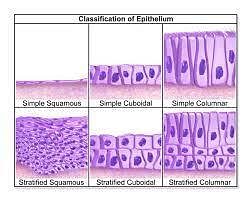UPSC Exam > UPSC Tests > Science & Technology for UPSC CSE > Test: Animal Tissues - 2 - UPSC MCQ
Test: Animal Tissues - 2 - UPSC MCQ
Test Description
20 Questions MCQ Test Science & Technology for UPSC CSE - Test: Animal Tissues - 2
Test: Animal Tissues - 2 for UPSC 2024 is part of Science & Technology for UPSC CSE preparation. The Test: Animal Tissues - 2 questions and answers have been
prepared according to the UPSC exam syllabus.The Test: Animal Tissues - 2 MCQs are made for UPSC 2024 Exam. Find important
definitions, questions, notes, meanings, examples, exercises, MCQs and online tests for Test: Animal Tissues - 2 below.
Solutions of Test: Animal Tissues - 2 questions in English are available as part of our Science & Technology for UPSC CSE for UPSC & Test: Animal Tissues - 2 solutions in
Hindi for Science & Technology for UPSC CSE course. Download more important topics, notes, lectures and mock
test series for UPSC Exam by signing up for free. Attempt Test: Animal Tissues - 2 | 20 questions in 20 minutes | Mock test for UPSC preparation | Free important questions MCQ to study Science & Technology for UPSC CSE for UPSC Exam | Download free PDF with solutions
Detailed Solution for Test: Animal Tissues - 2 - Question 1
Detailed Solution for Test: Animal Tissues - 2 - Question 2
| 1 Crore+ students have signed up on EduRev. Have you? Download the App |
Test: Animal Tissues - 2 - Question 3
The contractile protein of skeletal muscle involving ATPase activity is
Detailed Solution for Test: Animal Tissues - 2 - Question 3
Test: Animal Tissues - 2 - Question 4
Which of the following acts as antibody to help in body defence?
Detailed Solution for Test: Animal Tissues - 2 - Question 4
Detailed Solution for Test: Animal Tissues - 2 - Question 5
Test: Animal Tissues - 2 - Question 6
In a neuron, dendrite may be one or many, but axon is generally:
Detailed Solution for Test: Animal Tissues - 2 - Question 6
Detailed Solution for Test: Animal Tissues - 2 - Question 7
Test: Animal Tissues - 2 - Question 8
Which one of the following cellular components of the blood is responsible for the production of antibodies?
Detailed Solution for Test: Animal Tissues - 2 - Question 8
Test: Animal Tissues - 2 - Question 9
Which of the following is present in the alveoli of lungs?
Detailed Solution for Test: Animal Tissues - 2 - Question 9
Detailed Solution for Test: Animal Tissues - 2 - Question 10
Detailed Solution for Test: Animal Tissues - 2 - Question 11
Detailed Solution for Test: Animal Tissues - 2 - Question 12
Detailed Solution for Test: Animal Tissues - 2 - Question 13
Detailed Solution for Test: Animal Tissues - 2 - Question 14
Detailed Solution for Test: Animal Tissues - 2 - Question 15
Test: Animal Tissues - 2 - Question 16
Lysosome is a cytoplasmic organelle containingenzymesthat break down biological polymers. Lysosomes function as the digestive system of the cell. It is also called the suicide bag of the cell because:
Detailed Solution for Test: Animal Tissues - 2 - Question 16
Detailed Solution for Test: Animal Tissues - 2 - Question 17
Detailed Solution for Test: Animal Tissues - 2 - Question 18
Detailed Solution for Test: Animal Tissues - 2 - Question 19
Detailed Solution for Test: Animal Tissues - 2 - Question 20
|
146 videos|358 docs|249 tests
|
Information about Test: Animal Tissues - 2 Page
In this test you can find the Exam questions for Test: Animal Tissues - 2 solved & explained in the simplest way possible.
Besides giving Questions and answers for Test: Animal Tissues - 2, EduRev gives you an ample number of Online tests for practice
|
146 videos|358 docs|249 tests
|
Download as PDF


















